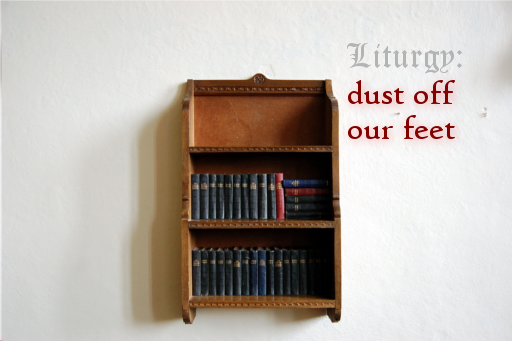I love liturgy. Not as a set of dead rules, but as something that brings life to common worship. In the more modern evangelical circles, however, where congregational polity is more frequent, it feels rather out of place. After all, clinging on to set words rather than hoping for the inspiration of the Holy Spirit comes across as Romish, backward and at its worst, in contradiction of what Paul says. To people who aren’t used to liturgy, it can look like brainwashing – speaking the words of the prayer without engaging your brain, nor your spirit.

Photo: Joe Dunckley, reused under CC license.
So it’s natural that us liturgy-lovers subconsciously jump to its defense. I’ve had conversations with friends where liturgy was defended as, simply, unavoidable. That whether official or not, there was always some level of modern liturgy lurking in the background. I’ve laughed when I saw videos taking fun of Christianese, because they describe exactly what that modern liturgy looks like. I’ve smiled at the use of “Amen” as a pious “Over” or “Over and out”.
But when I look at modern evangelical or charismatic Christianity in that way, all I’m doing is bring their practices down to the level of my, for wont of a better word, insecurities about traditional liturgy. Rather than looking at the positive in the very nature of liturgy, I’m discarding it as something we all do anyway. But in doing that, I don’t leave myself any space to say anything good about liturgy. So all I can do is look at some parts of the liturgy – specific prayers – and explain how much of a good prayer they are. And I have done that on a few occasions here. What I can’t do, is say why using more or less ancient forms of public worship is a good idea in and of itself.
Before I get into that, I should frame what I’m saying. Here’s what Hooker says:
True it is, the ancienter, the better ceremonies of religion are; howbeit, not absolutely true and without exception: but true only so far forth as those different ages do agree in the state of those things, for which at the first those rites, orders, and ceremonies, were instituted.
Preface to the Laws; chapter IV.4
Liturgy does not take precedence over relevance. If it really jars with either law or common secular practice, then you really need another reason to justify keeping the traditional liturgy going.
But as long as it’s not at complete odds with the culture of the age, Hooker concedes: the ancienter, the better. Why is that?
Going with tradition means inscribing yourself in a long line of worshippers before you and after you. There’s a famous image from Jewish tradition suggesting disciples should seek to be covered in the dust of their rabbi (as a result of being so close to them). I like to see liturgy in the same way as I see this dust: in itself, it is nearly insignificant; but it goes hand in hand with the attitude of a follower. And when the disciple turns rabbi, some of that dust will fall on their disciples; making an unbroken, worshipping communion that stretches through the ages.
But rejecting tradition means breaking that line. And that means breaking yourself off from future generations of worshippers too. The dust that you have lifted will be shaken off the sandals of those who follow you.
That’s why the ancienter the liturgy, the better. Because, intrinsically, it goes hand in hand with the truly humble attitude of following our forebears and allows us to lead on future generations. And simply on the basis that it has been kept alive for this long, suggesting that there might actually be something in it after all!
—
Liturgy is not a straitjacket, nor should it be treated as such. It is, however, wonderful to use it as a support for our worship: accepting it where appropriate and making it our own. To make it our own can take so many forms, too! We can mix it up, drawing from a variety of traditions; we can write our own prayers; we can experiment a little bit too. But let’s not be ashamed to look at the past to order our services.

Pingback: Size doesn’t matter « Ed's Slipper
Pingback: Liturgy: the same old stuff « Ed's Slipper